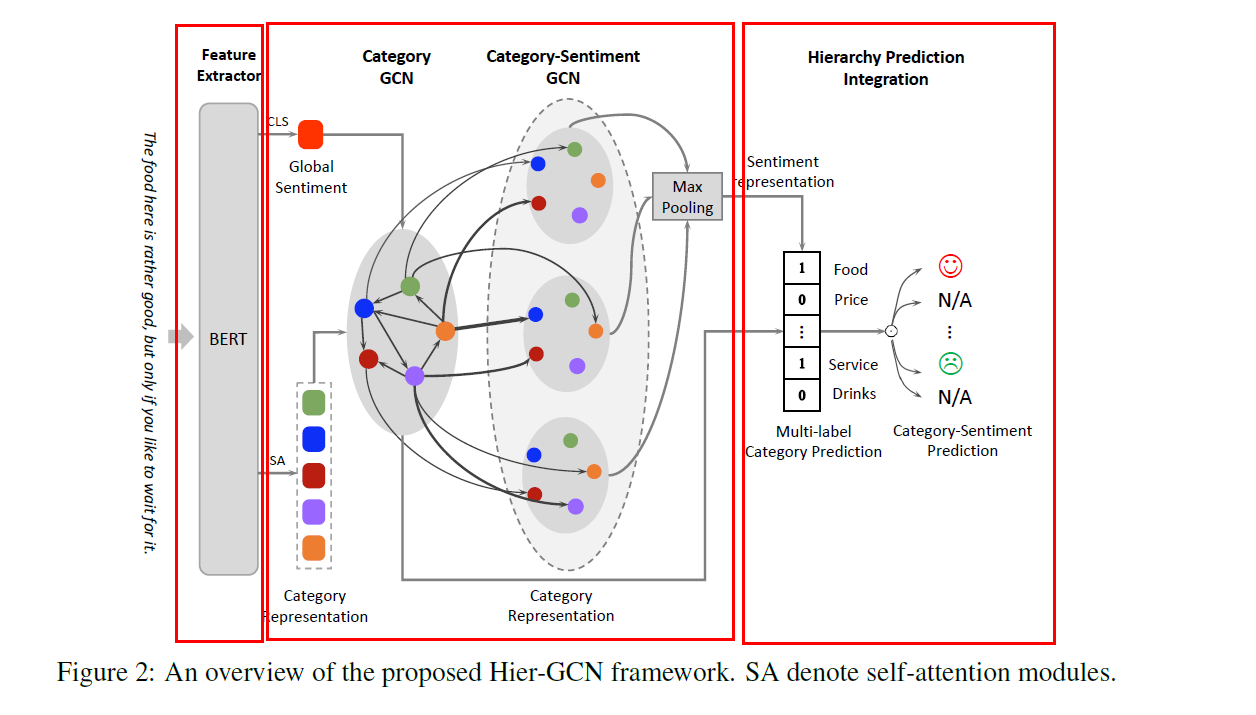Aspect-Category based Sentiment Analysis with Hierarchical Graph Convolutional Network (2020)
Contents
- Abstract
- Introduction
- Problem Formalization
- The Proposed Approach
- Feature Extraction with BERT
- Hier-GCN
- Category GCN Sub-Layer
- Category-Sentiment GCN Sub-Layer
- Hierarchical Prediction Integration
0. Abstract
대부분의 ABSA 연구들에서 말하는 “aspect”는..
- Explicit aspect (O)
- Implicit aspect (X)
둘 다 capture하기 위해, 이 논문은 Aspect-CATEGORY based sentiment analysis를 수행함
- (1) joint aspect category detection
- (2) category-oriented sentiment classification
ABSA task를 “category-sentiment hierarchy prediction”문제로써 바라본다.
- output : hierarchy output structure
- (1) 리뷰 내의 multiple aspect categories를 identify
- (2) 각각의 identified category에 대해 sentiment를 predict
Hier-GCN를 제안한다
- LOWER-level GCN : inner-relations among multiple categories
- HIGHER-level GCN : inter-relations between aspect categories & sentiments
1. Introduction
( 기존의 연구들 : ABSC, ATSA )
ABSC (Aspect Based Sentiment Classification )
- aspect 용어로부터 sentiment detect하기
- 한계점 : aspect 용어가 먼저 정해져야 (annotated)
ATSA (Aspect Term-based Sentiment Analysis )
- (1) aspect term extraction &
- (2) aspect sentiment classification을 jointly하게 수행
- 한계점 : only considers explicit aspects
이러한 위 두 방법론의 한계점에 대안으로, ACSA에 focus
ACSA (Aspect-Category based Sentiment Analysis)
-
ATSA와 마찬가지로 (1) & (2)를 동시에 jointly하게 수행
-
ATSA보다 나은 2가지?
- (a) 리뷰 내에 명시적으로 해당 aspect term을 사용하지 않았어도 OK
- (b) aspect term을 explicitly하게 뽑아내지 않아도, 문제 없음
( (a), (b) 다른게 뭐지…?? )
제안한 방법론 : Hier-GCN
- two-layer hierarchcy
- lower : aspect 찾기 ( multi-label classification … 여러 aspect 존재 가능)
- higher : sentiment 분류하기 ( multi-class classification … 하나의 sentiment만 가능 )
- 3개의 module로 구성
- (1) BOTTOM module : 2개의 subtask을 위한 hidden representation을 얻기 위해 BERT 사용
- (2) MIDDLE module : Hier-GCN
- (3) TOP module : category-sentiment hierarchy prediction 수행
2. Problem Formalization
Notation :
- \(n\)개의 단어 : \(r=\left[w_{1}, \ldots, w_{n}\right]\)
-
\(m\)개의 pre-defined aspect categories : \(\mathcal{C}=\left\{c_{1}, \ldots, c_{m}\right\}\)
- sentiment label들 : \(s=\) \(\{\) positive, negative, neutral }
ACSA의 Goal :
- category-sentence pair 생성하기 ( \(\left\{\ldots,\left(\hat{y}_{i}^{c}, \hat{y}_{i}^{s}\right), \ldots\right\}\) )
- \(\hat{y}_{i}^{c}\) : \(i\) -th aspect category mentioned in \(r\)
- \(\hat{y}_{i}^{s}\) : corresponding sentiment
- 위를 풀 수있는 여러 가지 대안/방안들?

(1) Cartesian Product
- 모든 combination pair를 고려
- multi-label classification
- \(\hat{y}_{i}^{c}=0\) : \(c_i\) 카데고리의 부재
- 문제점 : 하나의 aspect에 대해 여러 sentiment 가능성 있음!
(2) Add one dimension
-
각 category에 대해, 감정 여부 1/0으로!
-
multi-class classification
(3) Hierarchy
-
위의 (1) & (2)의 문제점 : two sub-task간의 internal relationship을 무시한다!
-
ACSA task를 category-sentiment hierarchy prediction 문제로 취급한다
\(p\left(\boldsymbol{y}^{c}, \boldsymbol{y}^{s} \mid \boldsymbol{r}\right)=p\left(\boldsymbol{y}^{c} \mid \boldsymbol{r}\right) p\left(\boldsymbol{y}^{s} \mid \boldsymbol{y}^{c}, \boldsymbol{r}\right),\).
- \(p\left(\boldsymbol{y}^{c} \mid \boldsymbol{r}\right)\) : multi-label classification
- \(p\left(\boldsymbol{y}^{s} \mid \boldsymbol{y}^{c}, \boldsymbol{r}\right)\) : multi-class classification
We adopt Bidirectional Encoder Representations from Transformers (BERT) as our sentence encoder, which is a pre-trained on a huge amount of text with masked language model and has been shown to achieve state-of-the-art results on a broad set of NLP tasks. Let \(H \in \mathbb{R}^{d \times(n+2)}\) denote the final hidden states generated from BERT, where we insert two special tokens (i.e., [CLS] and [SEP]) at the beginning and the end of each input \(r\). For space limitation, we omit a detailed description of BERT and refer readers to (Devlin et al., 2018).
For category representations, we further use \(m\) separate self-attention sub-layers on top of \(H\) to get the representations of \(m\) categories, denoted by \(C \in \mathbb{R}^{d \times m}\). Besides, following the practice in (Devlin
3. The Proposed Approach

(1) BERT : basic encoder로 사용
(2) Hier-GCN : 아래의 2가지를 포착
- inner relation between multiple category
- inter relation between categories & sentiment polarities
(3) Hierarchical output & Integration module
3-1) Feature Extraction with BERT
- BERT사용해서 feature extraction
3-2) Hier-GCN
3-2-1) Category GCN Sub-Layer
- inner-relations ( between categories ) 잡아내기 위해
- directed graph ( 각 category = 각각의 node )
- obtain adjacent matrix \(M^{c} \in \mathbb{R}^{m \times m}\)
- \(M_{i, j}^{c}\) 의 의미 : transition probability of having \(j\)th category, given \(i\)th category
- \(M_{i, j}^{c}= \begin{cases}\frac{\operatorname{count}\left(c_{i}, c_{j}\right)}{\operatorname{count}\left(c_{i}\right)+1} & i \neq j, \\ 1 & i=j .\end{cases}\).
- (서로 symmetric하지 않다)
- 위처럼 만들어진 matrix \(M^{c}\)로 graph convolution 수행
- \(\boldsymbol{X}_{l+1}=f\left(\boldsymbol{W}_{l} \boldsymbol{X}_{l} \boldsymbol{M}^{c}+\boldsymbol{b}_{l}\right)\).
- 마지막 Hier-GCN layer에서, multi-label classification 수행해서 다양한 category를 찾아내!
3-2-2) Category-Sentiment GCN Sub-Layer
- inter-relations ( between categories & sentiment ) 잡아내기 위해
-
directed graph ( \(m\)개의 category & \(3m\)개의 sentiment가 전부 node )
-
\(M_{i, j}^{c-s}= \begin{cases}\frac{\operatorname{count}\left(c_{i},\left(s \mid c_{j}\right)\right)}{\operatorname{count}\left(c_{i}\right)+1} & i \neq j \\ 1 & i=j\end{cases}\).
\(s \in\) \(\{\) positive, negative, neutral \(\} .\)
-
sentiment-sensitive category representation
\(\widehat{\boldsymbol{F}}_{l}=\operatorname{Tanh}\left(\boldsymbol{W}_{l}^{c, s} \boldsymbol{X}_{l+1} \oplus \boldsymbol{S}_{l}+\boldsymbol{b}_{l}^{c, s}\right)\).
\(\widetilde{\boldsymbol{F}}_{l}^{s}=f\left(\boldsymbol{W}_{l}^{s} \widehat{\boldsymbol{F}}_{l} \boldsymbol{M}^{c-s}\right)\).
\(\boldsymbol{S}_{l+1}=\operatorname{pooling}\left(\operatorname{dense}\left(\widetilde{\boldsymbol{F}}_{l}^{\text {pos }}\right) ; \operatorname{dense}\left(\widetilde{\boldsymbol{F}}_{l}^{\text {neg }}\right) ; \operatorname{dense}\left(\widetilde{\boldsymbol{F}}_{l}^{\text {neu }}\right)\right)\).
3-3) Hierarchical Prediction Integration
위에서 얻어낸..
- 3-1) category representation : \(\boldsymbol{X}_{i}\)
- 3-2) sentiment representation : \(S_{i}\)
을 사용하여, 다음을 계산한다.
\(\begin{gathered} p_{i}^{c}=p\left(y_{i}^{c} \mid \boldsymbol{r}\right)=\operatorname{sigmoid}\left(\boldsymbol{W}_{i}^{c} \boldsymbol{X}_{i}+b_{i}^{c}\right) \\ \boldsymbol{p}_{i}^{s}=p\left(\boldsymbol{y}_{i}^{s} \mid y_{i}^{c}, \boldsymbol{r}\right)=\operatorname{softmax}\left(\boldsymbol{W}^{s} \boldsymbol{S}_{i}+\boldsymbol{b}^{s}\right) \end{gathered}\).
이를 통해, 최종적으로..
- \(\left(\hat{y}_{i}^{c}, \hat{y}_{i}^{s}\right)=\left(\mathbb{I}\left(p_{i}^{c}>0.5\right), \arg \max \boldsymbol{p}_{i}^{s}\right)\).
ACSA의 loss part
-
(1) multi-label classification ( CE loss )
\(\operatorname{loss}^{c}=-\sum_{i=1}^{m} y_{i}^{c} \log p_{i}^{c}+\left(1-y_{i}^{c}\right) \log \left(1-p_{i}^{c}\right)\).
-
(2) multi-class classification ( NLL )
\(\operatorname{loss}^{s}=-\sum_{i=1}^{m} \sum_{j=1}^{3} \mathbb{I}\left(y_{i, j}^{s}\right) \log p_{i, j}^{s}\).
-
최종적인 loss : \(\operatorname{loss}=\operatorname{loss}^{c}+\operatorname{loss}^{s}\).
